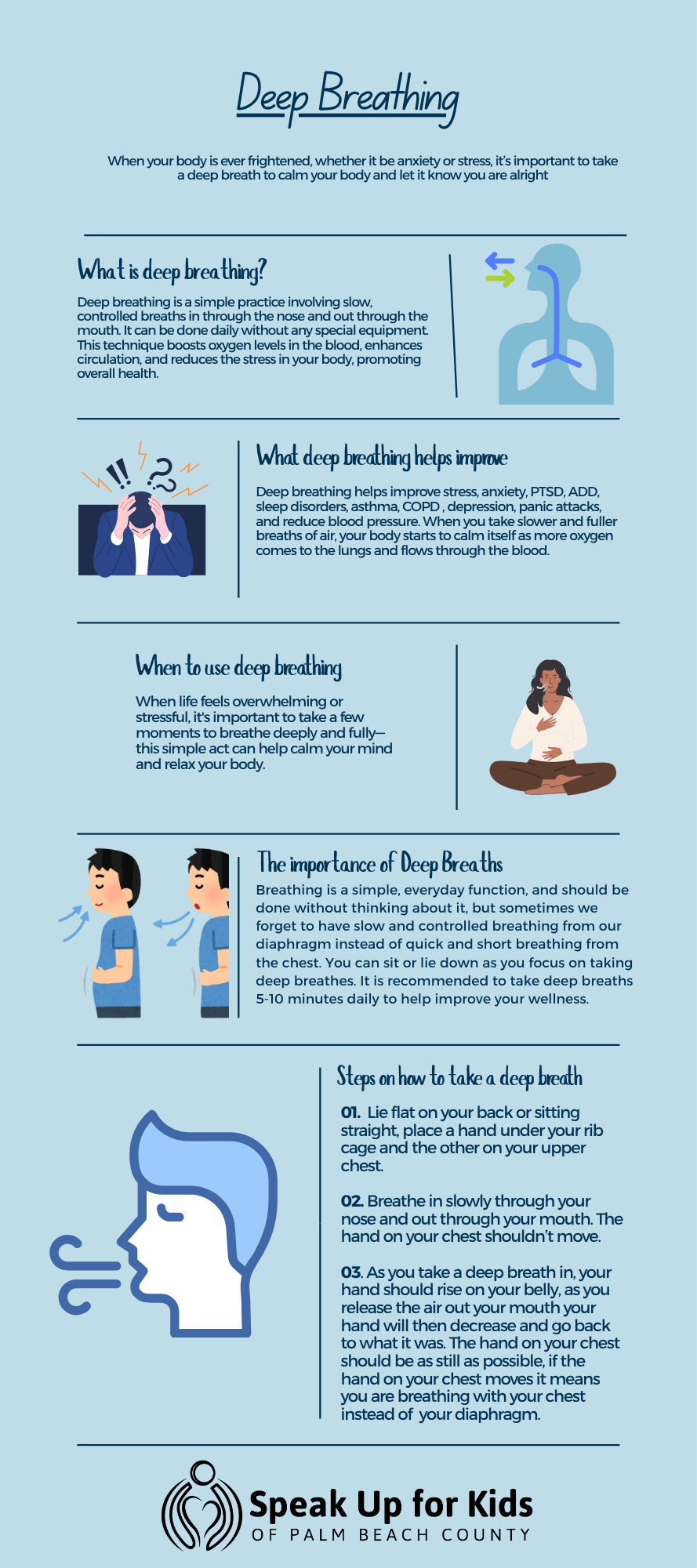How Deep Breathing Can Help You
Contributed by Shyla Woodkurm — Speak Up for Kids Student Intern, a homeschooled student with a passion for writing and music, self-taught pianist, and historical fiction author who enjoys editing, storytelling, and faith-based community engagement.
Overview
Deep breathing is an exercise everyone can do. There are two kinds of deep breathing: chest and diaphragmatic. Chest breathing is not the most beneficial way to inhale oxygen, instead, we should be breathing from our lungs and diaphragm. Many of us breathe quickly from our chest instead of taking deep breaths from our diaphragm, which is just above the stomach. Deep, slow breaths make our bellies expand when we inhale and shrink when we exhale. Deep breathing can help reduce anxiety, depression, stress, asthma, PTSD, panic attacks, and sleep disorders, while also supporting overall health and heart wellness.
What Does Deep Breathing Do?
“Studies in healthy humans have found that controlled slow breathing, particularly at 6 breaths per minute, is associated with an increase in fluctuations of both blood pressure and heart rate, compared to breathing at a typical rate.” - National Institution of Health.
Deep breathing involves slow and controlled breaths taken through the nose and released through the mouth. It can be done daily without equipment or an instructor. This practice increases oxygen levels in the blood, producing better circulation (how nutrients, oxygen, and hormones flow through your body) and reducing the workload on organs for oxygen.
What Does Deep Breathing Help With?
Deep breathing helps improve:
Anxiety
Stress
Panic Attacks
PTSD
Asthma
COPD
Reduce blood pressure
Depression
ADD
Sleep disorders
Note* ACEs (Adverse Childhood Experiences) can include certain mental health conditions that contribute to ongoing stress. Deep breathing helps promote relaxation and can ease many of the physical and emotional problems caused by constant stress and strain on the body.
How Can I Take Deep Breaths Properly?
Lying Down:
Lie flat on your back on a soft or comfortable surface.
Place one hand on your upper chest and the other just below your rib cage, this allows you to feel your diaphragm move as you breathe, helping you control it.
Breathe in slowly through your nose and notice your belly growing, causing your hand to rise. The hand on your chest shouldn’t move.
Then slowly exhale through your mouth, allowing your hand to move back down and your stomach to contract as you slowly release the air you breathed in. The hand on your chest should be as still as possible. When you breathe from your chest your shoulders will move up and down, avoid this when you can.
Sitting Up:
Sit comfortably with your knees and legs bent, and your neck and head relaxed.
Place one hand on your upper chest and the other below your rib cage. This allows you to feel your diaphragm move as you take a deep breath.
Breathe in slowly so that your stomach pushes out a little and watch your hand move, the hand on your chest should move as little as possible.
Tighten your stomach muscles and exhale slowly through your mouth, allowing your stomach to relax.
How Often Should I Practice Deep Breathing?
Deep breathing is a beneficial practice that promotes relaxation and overall wellness. Dedicating just 5-10 minutes a day to focus on your breathing can enhance your awareness of your respiratory (the system of the body that relates to breathing) patterns. This practice is most helpful for individuals experiencing anxiety of any form, as inhaling more oxygen helps reduce stress levels and causes you to relax.
Final Thoughts
When faced with stress, the body often responds by tightening up, leading to short and rapid breaths. Many people may not realize this change in their breathing during their everyday lives. However, taking a few minutes each day to concentrate on deep breathing can help restore calmness. As oxygen reaches the lungs and circulates through the body, it brings balance and ease.
Breathing is a natural, everyday function, but learning to breathe properly can significantly improve one's ability to manage stress. When stress is governed correctly, life becomes much more peaceful and easier to navigate.


